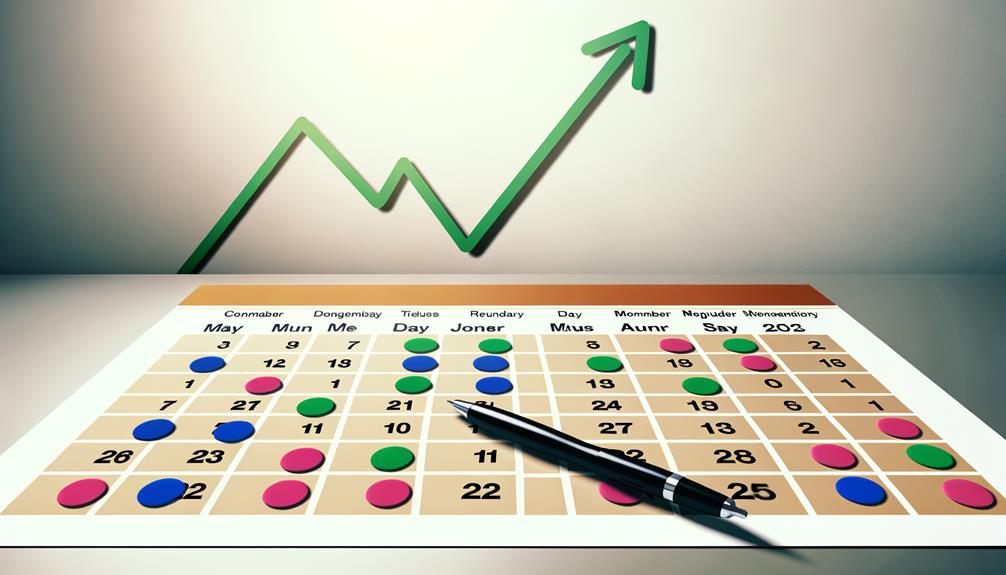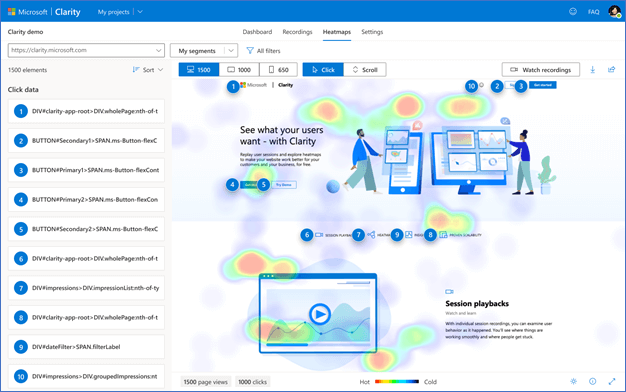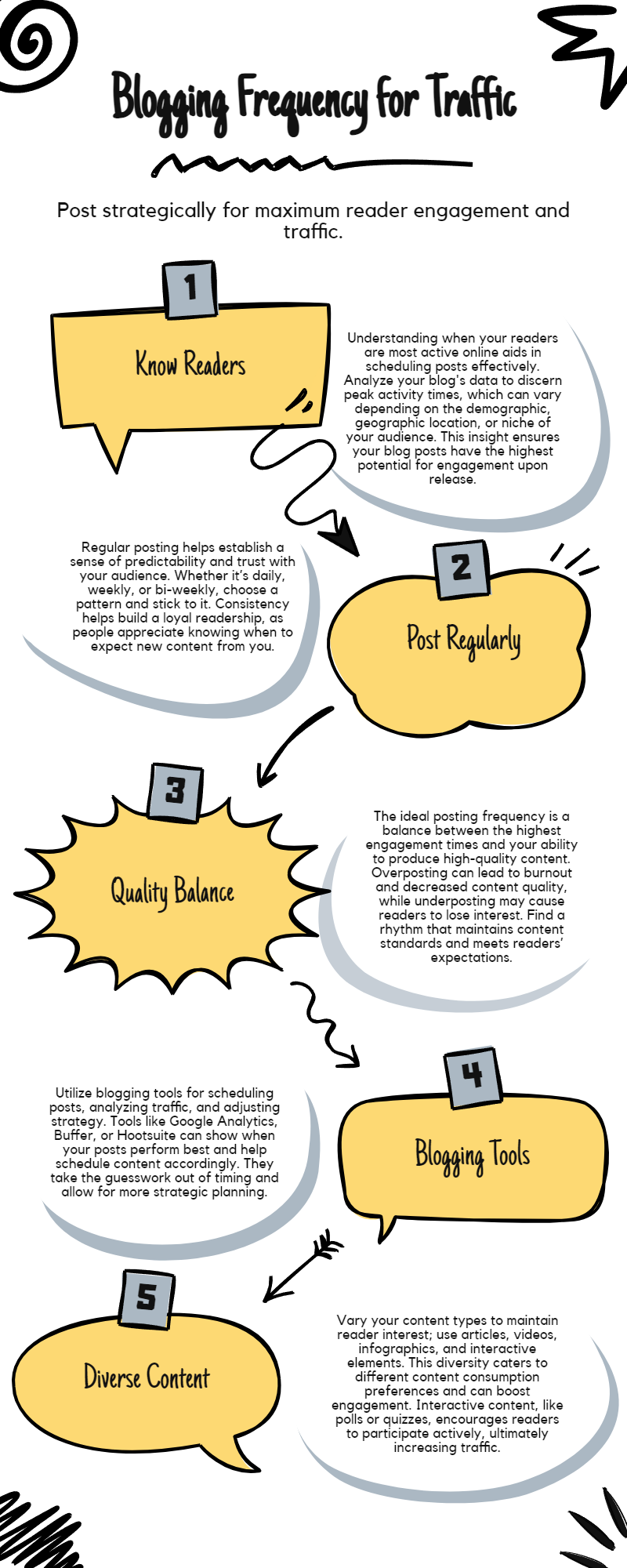

Pour attirer le plus grand nombre de visiteurs sur votre blog[2]Il s'agit donc de trouver le juste milieu entre ce que veulent vos lecteurs et ce que vous êtes en mesure de leur offrir de manière cohérente. Des articles réguliers et de qualité sont essentiels. Non seulement ils incitent vos lecteurs à revenir, mais ils permettent également à votre blog de grimper dans la hiérarchie des blogs. Google[3]dans les classements de recherche.
L'utilisation de données telles que les heures où votre blog reçoit le plus de trafic et le comportement de vos lecteurs peut vous aider à planifier le moment où vous devez publier vos articles. Des outils comme WordPress et un bon vieux calendrier de contenu peuvent vous aider à rester organisé. Garder un œil sur les performances de votre blog peut vous donner des informations utiles sur ce qui fonctionne et ce qui ne fonctionne pas.
Mais n'oubliez pas qu'il est essentiel de trouver un équilibre entre le nombre d'articles que vous publiez et votre capacité à continuer à produire un contenu de qualité. Vous voulez en savoir plus sur la façon d'augmenter le trafic de votre blog avec un mélange de types de contenu ? Restez à l'écoute...
N'oubliez pas qu'il n'existe pas de solution unique. Il s'agit d'un voyage d'essais et d'erreurs. Restez à l'écoute pour notre prochain article sur la façon de mesurer les performances de votre blog.
Il est clair que la fréquence et le moment où vous publiez vos articles ont une grande importance. Cela peut faire ou défaire la popularité et le succès de votre blog. Le fait de publier selon un calendrier précis, par exemple, peut susciter l'enthousiasme et l'impatience de vos lecteurs. Cela vous aide à constituer un groupe de fidèles au fil du temps.
Pourquoi ? Parce que lorsque vous partagez régulièrement du contenu de qualité, les gens prennent l'habitude de consulter votre blog. Cela peut accélérer leur passage du statut de visiteur à celui d'acheteur. De plus, les règles de Google en coulisses favorisent un contenu régulier et de qualité. Cela signifie que le maintien d'un rythme de publication régulier peut aider votre blog à grimper dans l'échelle de classement de Google.
Pour que votre blog fonctionne au mieux, il est essentiel d'observer ce que font vos lecteurs. Cela signifie qu'il faut vérifier quand la plupart des gens visitent votre site, savoir qui ils sont, voir ce qui attire leur attention et garder un œil sur la façon dont ils interagissent avec vos articles sur les médias sociaux.
L'utilisation de ces périodes de forte affluence à votre avantage peut vous aider à décider du moment où vous devez publier. Apprendre à connaître les antécédents et les goûts de vos lecteurs peut vous aider à déterminer ce que vous publiez et quand vous le faites. Le nombre de clics sur vos publications et la durée d'affichage peuvent vous indiquer ce qui suscite leur intérêt. Les partages et les commentaires que vous obtenez sur les médias sociaux vous indiquent à quel point vos lecteurs sont engagés et ce qui les intéresse. Et les sondages ? C'est un excellent moyen de savoir ce que vos lecteurs aiment.

Veillez à vérifier votre Google Search Console[1] pour obtenir des informations et des installer Microsoft Clarity pour obtenir des cartes thermiques gratuites pour voir combien de temps les lecteurs restent sur votre page, où ils cliquent, interagissent, etc.
Que se passe-t-il lorsque vous mettez toutes ces méthodes en pratique ? Restez à l'écoute pour le découvrir.

I
Il est essentiel de savoir comment publier des articles de manière efficace pour rendre votre blog plus visible, plus attrayant et plus bénéfique pour votre processus de vente. Une routine régulière d'articles de blog fréquents peut augmenter de manière significative le trafic organique - parce que les moteurs de recherche aiment le contenu régulier et de haute qualité.
Mais à quelle fréquence devez-vous publier ? Cela dépend de la réaction de votre public et de votre capacité à continuer à produire du contenu de qualité. Un calendrier de contenu est un outil pratique pour planifier une stratégie de contenu solide et respecter une routine de publication régulière. Cela peut aider votre marque à se faire connaître, car votre public commence à attendre avec impatience vos publications régulières.
Discutons de la manière dont vous pouvez mesurer les performances de votre blog. Pensez-y comme à un bulletin de notes pour votre blog.
Le nombre de vues et de visiteurs uniques vous indique combien de personnes s'arrêtent sur votre site. Le taux de rebond et le temps passé sur votre blog permettent de savoir si les visiteurs lisent réellement vos articles ou s'ils se contentent de cliquer.
Les internautes partagent-ils vos articles sur les médias sociaux ? Cliquent-ils sur les liens que vous leur proposez ? Ces actions montrent que votre blog incite les gens à faire quelque chose.
Où votre blog apparaît-il lorsque les internautes recherchent des mots-clés pertinents ? D'autres sites renvoient-ils vers votre blog ? Ces facteurs peuvent vous indiquer si votre blog est facile à trouver sur les moteurs de recherche.
Gardez un œil sur ces mesures et adaptez votre stratégie de blogging pour que votre public en redemande. Mais que faire si vous avez encore du mal à améliorer les performances de votre blog ? Restez à l'écoute pour découvrir quelques astuces secrètes.
Si l'idée de la recherche de mots-clés et de l'optimisation du contenu vous semble insurmontable, nous sommes là pour vous aider. Nos spécialistes sont prêts à élaborer une stratégie de référencement qui répond à vos besoins et objectifs uniques. Prenez contact avec nous dès maintenant via notre page de contact ou discutez avec nous instantanément sur WhatsApp pour une assistance rapide et professionnelle.
L'utilisation d'outils de blogage tels que WordPress, Squarespace et Wix peut simplifier votre parcours de blogueur. Ces outils vous permettent d'assurer la cohérence de vos articles et d'améliorer les performances de votre blog à l'aide d'outils d'analyse intégrés. Vous planifiez vos articles à l'avance ? Ces outils vous couvrent. Ils vous permettent de programmer des articles à des dates et heures précises, afin que votre blog reste actif et que vos lecteurs soient attirés. Vous pouvez même rédiger et enregistrer des articles pour plus tard, ce qui vous facilite la tâche.
De plus, ces outils sont dotés d'une fonction d'analyse. Elle vous permet de voir comment vos articles se comportent et d'ajuster vos heures de publication en fonction des données recueillies. En d'autres termes, ces outils de blogging peuvent vous aider à attirer davantage de visiteurs sur votre blog. Mais comment y parviennent-ils exactement ? Restez à l'écoute pour le découvrir.
Si vous cherchez à attirer davantage de visiteurs sur votre blog, pensez à diversifier le type de contenu que vous proposez. En mélangeant les contenus et en attirant un plus large éventail d'intérêts, vous pourriez voir augmenter le nombre de personnes qui consultent votre blog.
Voici comment procéder :
Tout d'abord, essayez d'inclure des infographies et des données chiffrées dans vos articles de blog. Ils sont non seulement faciles à comprendre, mais ils sont également plus susceptibles d'attirer l'attention de votre lecteur.
Deuxièmement, modifiez le format de votre contenu. Pensez à inviter des auteurs, à interviewer des experts, à partager des vidéos et même à lancer un podcast. Vous aurez ainsi plus de chances d'atteindre de nouvelles personnes qui n'auraient peut-être pas trouvé votre blog autrement.
Enfin, pourquoi ne pas rendre votre blog plus interactif ? En ajoutant des quiz, des sondages ou des enquêtes, vous donnez à vos lecteurs la possibilité de s'intéresser à votre contenu. Cela peut contribuer à augmenter le nombre de personnes qui visitent votre blog.
La réussite d'un blog ne se fait pas du jour au lendemain. Il s'agit d'un mélange de plusieurs ingrédients clés. Tout d'abord, vous avez besoin d'un contenu de premier ordre qui attire l'attention. Ensuite, vos lecteurs doivent participer activement, en commentant et en partageant vos articles. N'oubliez pas le référencement - ces termes sophistiqués qui permettent à votre blog d'apparaître dans les résultats des moteurs de recherche.
Vous devez également être habile sur les médias sociaux, en publiant et en promouvant votre blog afin d'atteindre un public plus large. Collaborer avec des influenceurs dans votre domaine et faire du guest blogging sur leurs plateformes peut également stimuler la visibilité de votre blog.
Rédiger de longs articles contenant des informations utiles et les agrémenter de vidéos, d'images et d'autres supports multimédias peut rendre votre contenu plus attrayant. Mais la chose la plus importante est peut-être la cohérence. Vous devez bloguer régulièrement, mais à quelle fréquence ? Cela dépend du sujet de votre blog et de votre public.
Pour attirer plus d'attention sur votre blog, essayez d'écrire 3 à 4 articles par semaine. Mais ne vous concentrez pas uniquement sur la quantité. Veillez à ce que chaque article soit de qualité, qu'il suscite l'intérêt de vos lecteurs et qu'il contienne des astuces de référencement. Faites la promotion de vos articles sur les réseaux sociaux, utilisez des mots clés judicieusement et respectez un calendrier régulier. Tout votre contenu doit être attrayant, pertinent pour votre niche et encourager l'interaction. Vous souhaitez en savoir plus ? Restez à l'écoute pour d'autres conseils sur la manière d'augmenter le trafic de votre blog.
Le meilleur plan de publication d'articles de blog est un mélange délicat. Il s'agit de publier régulièrement des articles, d'accrocher vos lecteurs et de satisfaire Google. Vous devez vous concentrer sur la création d'un contenu de qualité supérieure plutôt que de vous contenter de publier des articles à la chaîne. Il est essentiel de veiller à ne pas s'épuiser et de respecter votre calendrier de rédaction. Ce que vous écrivez doit correspondre au thème de votre blog, et le fait de partager vos articles sur les médias sociaux peut aider vos lecteurs à en redemander. Mais n'oubliez pas, quelle est la formule magique derrière cette stratégie ? Restez à l'écoute de notre prochain article pour le découvrir.
Le nombre idéal de blogs à publier chaque mois n'est pas immuable. Il dépend de plusieurs facteurs. Tout d'abord, la qualité de ce que vous écrivez est importante, tout comme l'interaction de vos lecteurs avec vos articles. La façon dont vous utilisez les techniques d'optimisation des moteurs de recherche (SEO), la pertinence de votre sujet et la façon dont vous faites la promotion de votre blog jouent également un rôle.
Si vous jonglez avec différents types de contenu, comme des articles longs et courts ou des articles d'invités, vous maintiendrez l'intérêt de vos lecteurs. Des mises à jour régulières et un contenu intemporel toujours utile peuvent les inciter à revenir.